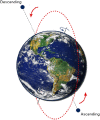Identification of Maya ruins covered by jungle using Sentinel-1
- PMID: 38332214
- PMCID: PMC10853246
- DOI: 10.1038/s41598-024-53068-2
Identification of Maya ruins covered by jungle using Sentinel-1
Abstract
Archaeologists commonly use airborne LIDAR technology to produce 3D models of structures, even when obscured by a forest canopy. However, this technology has a high cost, both from the plane itself and from the processing of the LIDAR point cloud. Furthermore, this technique can only be used over limited regions. This paper proposes a technique that uses SAR satellite imagery to identify man-made structures hidden by a forest canopy. To do so, we exploit the Ascending and Descending passes of Sentinel-1 so that we obtain two images of the candidate site but from different sight directions. Because of cardinal effects, a large enough building will sign differently from the comparatively isotropic forest canopy it is obscured by. Practically, the technique is based on the ratio of backscattered intensity from these two illumination angles and is well adapted for large areas. The advantages and shortcomings are discussed for the specific case of Sentinel-1 SAR images over two Maya archaeological sites in Central America. Our analysis shows that SAR satellite imagery might provide a free, global-scale way of preselecting sites with large or tall structures to complement LIDAR technology.
© 2024. The Author(s).
Conflict of interest statement
The authors declare no competing interests.
Figures

















References
-
- Devereux B, Amable G, Crow P, Cliff A. The potential of airborne lidar for detection of archaeological features under woodland canopies. Antiquity. 2005;79:648–660. doi: 10.1017/S0003598X00114589. - DOI
-
- Šprajc I, et al. Ancient Maya water management, agriculture, and society in the area of Chactún, Campeche. Mexico. J. Anthropol. Archaeol. 2021;61:101261. doi: 10.1016/j.jaa.2020.101261. - DOI
-
- Thompson, A. E. Detecting classic Maya settlements with Lidar-derived relief visualizations. Remote Sens.12, 10.3390/rs12172838 (2020).
-
- Bundzel, M. et al. Semantic segmentation of airborne LiDAR data in Maya archaeology. Remote Sens.12, 10.3390/rs12223685 (2020).
-
- Taillade, T., Thirion-Lefevre, L. & Guinvarc’h, R. Detecting ephemeral objects in SAR time-series using frozen background-based change detection. Remote Sens.12, 10.3390/rs12111720 (2020).
LinkOut - more resources
Full Text Sources
Miscellaneous

